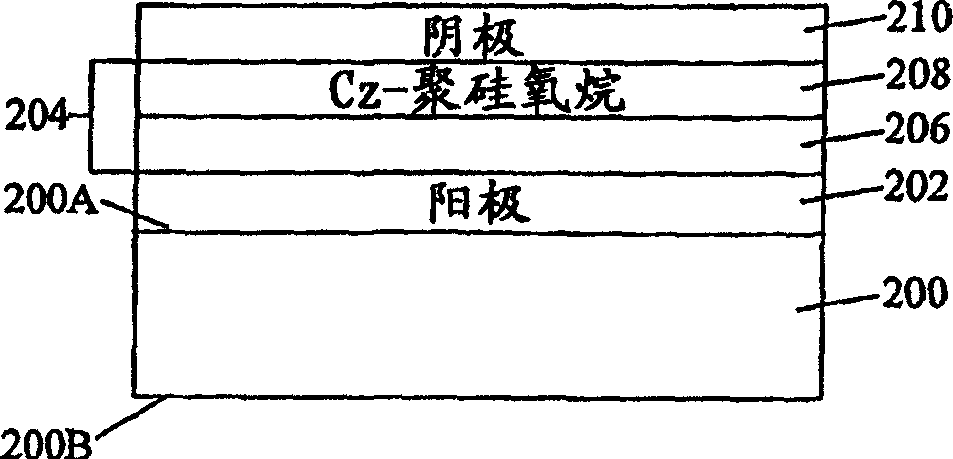Carbazolyl-functional linear polysiloxanes, silicone composition, and organic light-emitting diode
A technology of carbazole-based functional polysiloxane, which is applied in the direction of luminescent materials, electroluminescent light sources, light sources, etc., can solve the problems of undisclosed siloxane compositions, etc., and achieve improved electroluminescence efficiency and good wear resistance performance, good primer-free adhesion
- Summary
- Abstract
- Description
- Claims
- Application Information
AI Technical Summary
Problems solved by technology
Method used
Image
Examples
Embodiment 1
[0224] Embodiment 1: Preparation of poly[3-(N-carbazolyl)propylmethylsiloxane]
[0225] In a dry flask equipped with a magnetic stirrer, nitrogen inlet, and thermometer, combine N-allylcarbazole (11.40 g, 0.055 mol) in an amount sufficient to provide a degree of polymerization (dp) of 0.05 mol silicon-bonded hydrogen atoms 115 trimethylsiloxy-terminated poly(methylhydrogensiloxane), and 10 g of anhydrous toluene. Composed of 62% 1,3-divinyl-1,1,3,3-tetramethyldisiloxane and 38% 1,3-divinyl-1,1,3,3-tetramethyldisiloxane A solution of a platinum (IV) complex of an oxane was added to the mixture in an amount sufficient to obtain a platinum concentration of 10 ppm. The flask was placed in an oil bath at 60°C, and the progress of the reaction was monitored by periodically withdrawing aliquots of the mixture for FTIR analysis. When at 2100-2200cm -1 At the point when Si-H uptake was no longer evident, the solvent was removed by venting the flask, continuously purging the system w...
Embodiment 2
[0228] Embodiment 2: Preparation of poly[3-(N-carbazolyl)propylethylsiloxane]
[0229] The title compound was prepared using the method of Example 1 except that poly(methylhydrogensiloxane) was replaced by trimethylsiloxy-terminated poly(ethylhydrogensiloxane) having a viscosity of 75-125 cSt at 25°C oxane), and the reaction mixture was heated at 60 °C for 2 hours before the solvent was removed. The IR spectrum of the mixture shows that at 2141cm -1 There is a weak absorption at , demonstrating the presence of 1-5 mol% residual Si-H groups in the polysiloxane product.
[0230] product of 13 The C NMR spectrum shows that the corresponding Si-CH 2 -CH 2 Signals at 22.3 ppm and 14.6 ppm for radicals. 29 Si NMR spectroscopy demonstrated a weak signal at -36.6 ppm, demonstrating the presence of residual Si-H groups. TGA results showed that the decomposition temperature of polysiloxane was 380°C in air and 420°C in helium. Table 1 shows the optical properties of the carbazoly...
Embodiment 3
[0233] Example 3: Preparation of poly{[3-(N-carbazolyl)propylethylsiloxane]-co-[2-(trimethoxysilylpropoxycarbonyl)-2-methylethyl Silicone]}
[0234] Combine N-allylcarbazole (4.92g, 0.024mol) in a flask under nitrogen, 1.5g trimethylsiloxy-terminated poly(methylhydrogensiloxane) with a dp of 115, 0.3g ( 1.2 mmol) of 3-methacryloxypropyltrimethoxysilane and 6 g of anhydrous toluene. After mixing thoroughly, using a syringe, 0.06 g of 0.31% 1,3-divinyl-1,1,3,3-tetramethyldisiloxane and 0.19% 1,3-divinyl-1 , A solution of the platinum(IV) complex of 1,3,3-tetramethyldisiloxane in 2-propanol was added to the mixture. The flask was placed in an oil bath at 80°C for 4 hours. A second portion of 3-methacryloxypropyltrimethoxysilane (0.3 g, 1.2 mmol) was added to the mixture. After heating the mixture at 80° C. for an additional 2 hours, 1.0 g (4.8 mmol) of N-allylcarbazole was added to the mixture. The solvent was removed by venting the flask, continuously purging the system wit...
PUM
 Login to View More
Login to View More Abstract
Description
Claims
Application Information
 Login to View More
Login to View More - R&D
- Intellectual Property
- Life Sciences
- Materials
- Tech Scout
- Unparalleled Data Quality
- Higher Quality Content
- 60% Fewer Hallucinations
Browse by: Latest US Patents, China's latest patents, Technical Efficacy Thesaurus, Application Domain, Technology Topic, Popular Technical Reports.
© 2025 PatSnap. All rights reserved.Legal|Privacy policy|Modern Slavery Act Transparency Statement|Sitemap|About US| Contact US: help@patsnap.com



